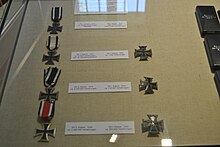
Back الصليب الحديدي Arabic "Dəmir xaç" ordeni Azerbaijani Жалезны крыж Byelorussian Жалезны крыж BE-X-OLD Железен кръст Bulgarian লৌহ ক্রুশ Bengali/Bangla Creu de Ferro Catalan Železný kříž Czech Jernkorset Danish Eisernes Kreuz German
This article needs additional citations for verification. (January 2023) |

The Iron Cross (German: Eisernes Kreuz, ⓘ, abbreviated EK) was a military decoration in the Kingdom of Prussia, and later in the German Empire (1871–1918) and Nazi Germany (1933–1945). The design, a black cross pattée with a white or silver outline, was derived from the insignia of the medieval Teutonic Order and borne by its knights from the 13th century. As well as being a military medal, it has also been used as an emblem by the Prussian Army, the Imperial German Army, and the Reichswehr of the Weimar Republic, while the Balkenkreuz (bar cross) variant was used by the Wehrmacht. The Iron Cross is now the emblem of the Bundeswehr, the modern German armed forces.


King Frederick William III of Prussia established the Iron Cross award on 17 March 1813 during the Napoleonic Wars (EK 1813). The award was backdated to the birthday (10 March) of his late wife, Queen Louise, who was the first person to receive it (posthumously). The Iron Cross was also awarded during the Franco-Prussian War (EK 1870), World War I (EK 1914), and World War II (EK 1939). During World War II, the Nazi regime made their own version by superimposing a swastika on the medal. The Iron Cross was usually a military decoration only, though some were awarded to civilians for performing military roles, including Hanna Reitsch and Melitta Schenk Gräfin von Stauffenberg for being civilian test pilots during World War II.
Since the late 20th century, the symbol has also been adopted into the outlaw motorcycle subculture and heavy metal fashion.